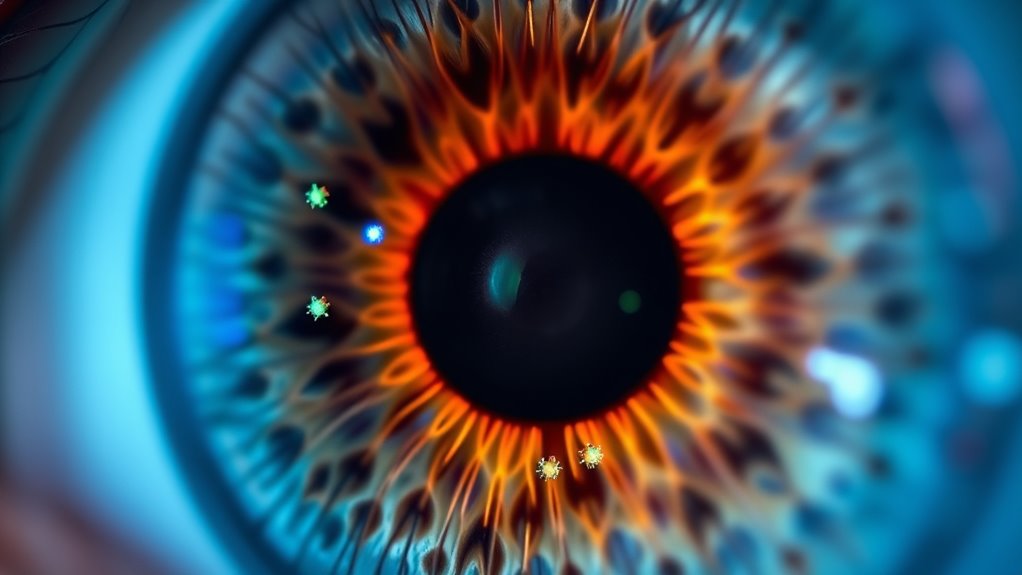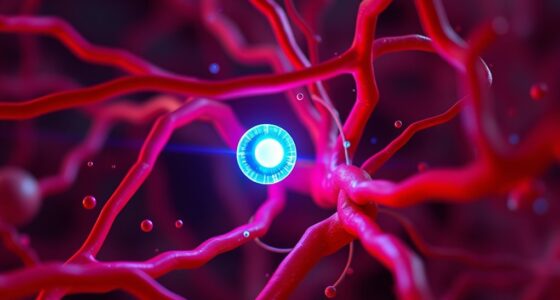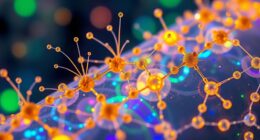Nanomachines in ophthalmology are tiny devices designed to precisely deliver drugs within your eyes, targeting specific tissues like the retina or the anterior chamber. They navigate ocular barriers, release medications on demand, and reduce side effects by ensuring drugs only reach the needed areas. These innovations lead to less invasive treatments, faster recovery, and better outcomes for eye diseases such as glaucoma and AMD. Keep exploring to discover how these advances could transform your eye care options.
Key Takeaways
- Nanomachines enable targeted, precise drug delivery within the eye, crossing complex ocular barriers effectively.
- They enhance drug stability, prolong release, and reduce dosing frequency for eye disease treatments.
- Responsive to environmental cues, nanomachines allow controlled, site-specific drug release, minimizing side effects.
- Surface modifications help nanomachines evade immune detection, ensuring safe and sustained therapy in ocular tissues.
- Advances include minimally invasive, personalized treatments for conditions like AMD and glaucoma, improving patient outcomes.
What Are Nanomachines and How Do They Work in Eye Care
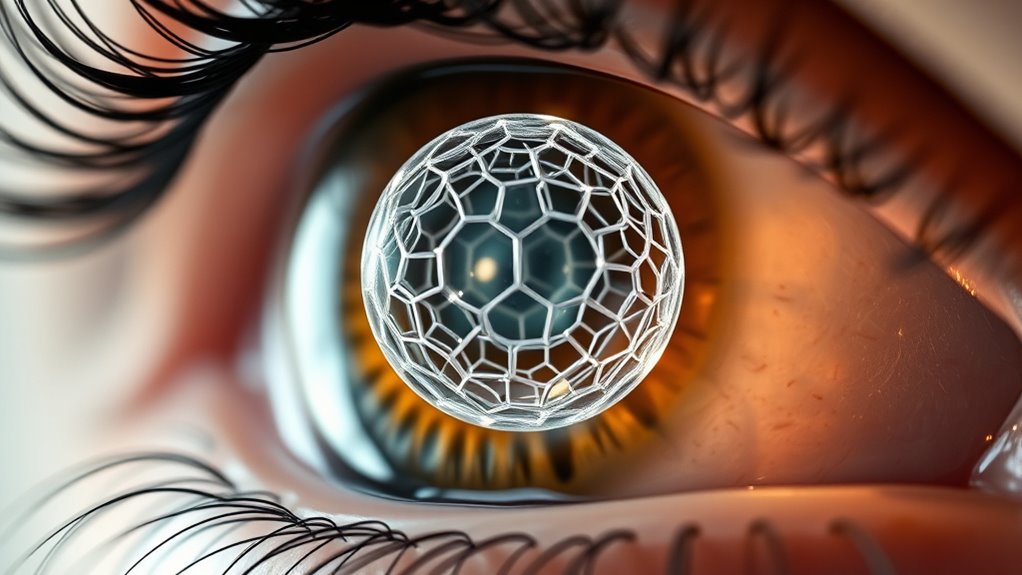
Nanomachines are tiny, engineered devices that operate at the molecular level to perform specific tasks. In eye care, you can think of them as microscopic tools designed to deliver drugs precisely where needed, without affecting surrounding tissues. They work by recognizing target cells or molecules, then releasing medication directly at the site of disease or damage. These devices can be powered by chemical reactions or external stimuli, such as light or magnetic fields, to activate their functions. Because they’re so small, nanomachines can navigate through the eye’s complex structures, crossing barriers that typically prevent drug delivery. Their ability to target specific cells enhances treatment precision and minimizes side effects, making nanomachines a promising innovation in ophthalmology.
Advantages of Using Nanomachines for Ocular Drug Delivery

Using nanomachines for ocular drug delivery offers you precise targeting, ensuring medicines reach the exact eye tissues needed. This accuracy helps reduce side effects and minimizes damage to surrounding areas. Plus, nanomachines improve drug stability, making treatments more effective and longer-lasting. Additionally, advancements in projector technology demonstrate the importance of high resolution and contrast ratios in visual applications, which is analogous to the precision needed in targeted drug delivery systems.
Precise Targeting Capabilities
Because of their tiny size and sophisticated design, nanomachines can precisely target specific cells or tissues within the eye, minimizing damage to surrounding structures. This accuracy guarantees that medication reaches only the intended areas, boosting treatment effectiveness. You benefit from reduced drug wastage and fewer side effects since the medication doesn’t affect other parts of the eye. Nanomachines can also adapt to the eye’s microenvironment, enabling controlled release of drugs over time. Their ability to recognize specific molecular markers allows for targeted therapy of diseased cells while sparing healthy tissue. Effective drug delivery is further enhanced by their capacity to navigate complex ocular barriers with ease.
Reduced Side Effects
By targeting only the diseased cells and tissues, nanomachines markedly reduce the risk of unwanted side effects that often accompany traditional ocular treatments. Since they deliver drugs precisely where needed, you’ll experience fewer issues like irritation or toxicity elsewhere in the eye. This targeted approach minimizes systemic exposure, lowering chances of adverse reactions. It also helps prevent damage to healthy tissues, preserving overall eye health.
| Benefit | Explanation |
|---|---|
| Fewer Side Effects | Reduced exposure to healthy tissues decreases adverse reactions. |
| Higher Treatment Tolerance | Patients are more comfortable with less irritation. |
| Minimized Toxicity | Less drug leakage into non-target areas lessens toxicity. |
| Improved Safety | Precise delivery ensures safer, more effective treatments. |
Enhanced Drug Stability
Nanomachines markedly enhance drug stability during ocular treatment, ensuring that medications remain effective for longer periods. By protecting drugs from degradation caused by enzymes, light, or pH changes, they help maintain potency throughout storage and application. This stability reduces the frequency of dosing, making treatments more convenient and reliable. Additionally, nanomachines can control the release rate, preventing sudden drug spikes and ensuring consistent therapeutic levels. This precise delivery minimizes waste and enhances patient compliance. With improved stability, drugs are less susceptible to premature breakdown, leading to better clinical outcomes. Furthermore, the integration of tuning techniques from automotive applications demonstrates how precision control can optimize drug delivery systems for improved efficacy.
Targeted Treatment of Glaucoma With Nanotechnology
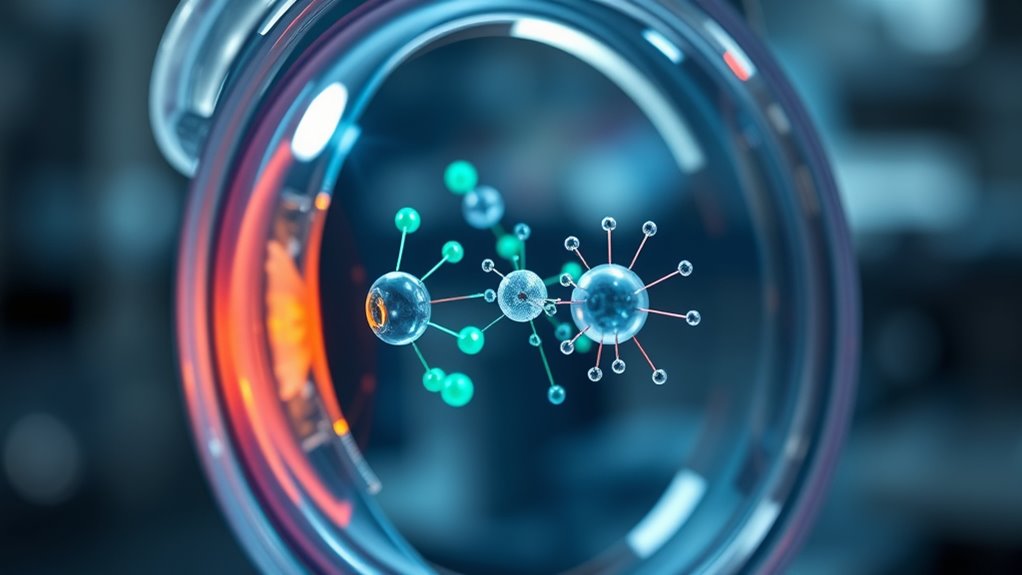
Targeted treatment of glaucoma with nanotechnology offers a promising approach to improve patient outcomes. By using nanocarriers, you can deliver drugs directly to the eye’s specific tissues, such as the trabecular meshwork or optic nerve. This precision reduces side effects associated with traditional treatments and enhances drug efficacy. Nanoparticles can penetrate ocular barriers, ensuring sustained release and better absorption, so you need fewer doses and experience fewer fluctuations in intraocular pressure. Additionally, nanotechnology enables you to customize drug formulations, making treatments more effective for individual needs. This targeted approach not only improves symptom management but also helps protect your vision over the long term, representing a significant advancement in glaucoma therapy.
Enhancing Therapy for Age-Related Macular Degeneration
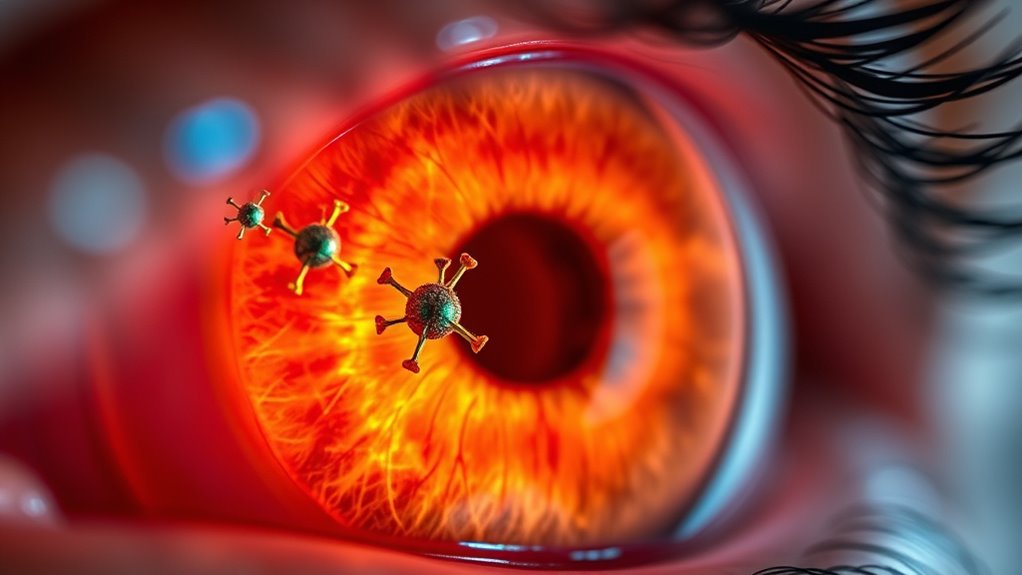
Nanomachines can improve treatment for age-related macular degeneration by precisely targeting drugs to affected areas, reducing side effects. They also enable minimally invasive delivery methods, making procedures safer and more comfortable. This approach offers the potential to substantially enhance therapy outcomes for patients. To ensure effective treatment, it is essential to consider skin sensitivity and tailor the approach accordingly.
Precise Drug Targeting
Advancements in nanotechnology are now enabling unprecedented precision in delivering drugs directly to affected areas of the eye, particularly for age-related macular degeneration (AMD). This means you can target the disease with minimal impact on healthy tissue, reducing side effects and increasing treatment effectiveness. Nanomachines can navigate complex eye structures to reach the macula precisely. They respond to specific biological signals, releasing drugs only when needed. This approach ensures higher drug concentration at the disease site and lower systemic exposure. Moreover, the integration of latest innovations in nanomedicine allows for even more refined control over drug release profiles, further enhancing therapeutic outcomes. – Targeted delivery reduces the frequency of injections – Minimizes damage to surrounding healthy tissue – Allows controlled, on-demand drug release – Improves overall patient comfort and compliance
Minimally Invasive Delivery
Because traditional eye injections can be invasive and uncomfortable, researchers are now focusing on minimally invasive delivery methods to treat age-related macular degeneration. These innovative approaches aim to reduce discomfort while ensuring effective therapy. Nanomachines enable targeted delivery through eye drops, implants, or nanocarriers that bypass the need for injections. They can release medication gradually, maintaining consistent drug levels. This minimizes side effects and improves patient adherence. Techniques like microneedles and biodegradable implants offer additional options for less invasive treatment. Here’s a quick overview:
| Method | Description | Benefits |
|---|---|---|
| Eye drops | Nanoparticles penetrate ocular tissues | Easy application, non-invasive |
| Microneedles | Tiny, painless insertion | Minimally invasive, precise |
| Biodegradable implants | Slow drug release over time | Reduced frequency, comfort |
| Subconjunctival injections | Less invasive than traditional | Lower discomfort, effective |
| Nanocarriers | Targeted delivery to retina | Increased efficacy, safety |
A new sentence with ocular drug delivery and the rest of the sentence.
Nanomachines in Managing Diabetic Retinopathy
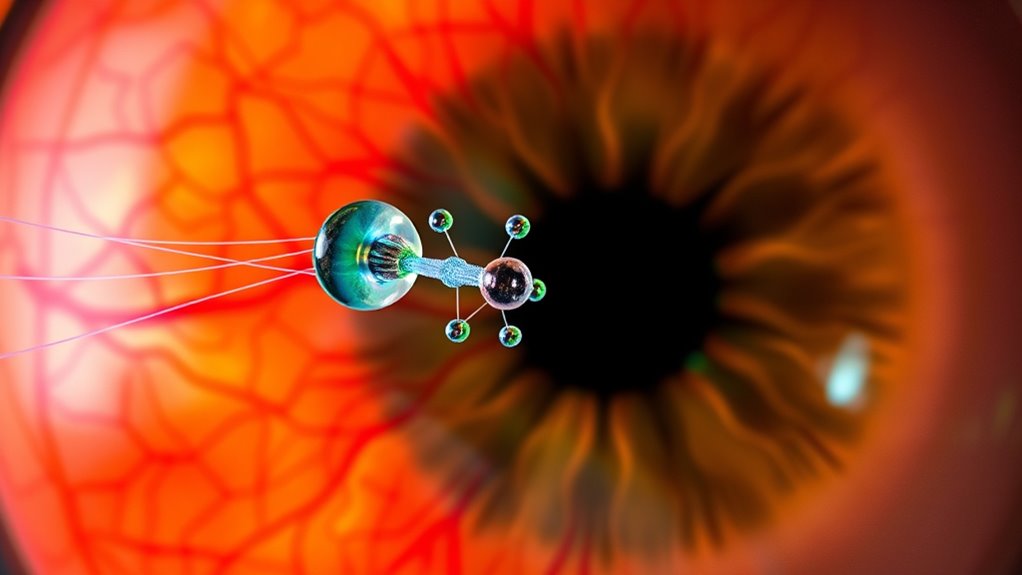
Managing diabetic retinopathy, a leading cause of vision loss, has become more promising with the emergence of nanomachines designed for targeted therapy. These tiny devices can deliver medication directly to affected retinal tissues, minimizing side effects and increasing treatment efficiency. By precisely targeting damaged blood vessels and inflamed areas, nanomachines help slow disease progression and preserve vision. They also can release drugs in response to specific retinal signals, ensuring ideal timing and dosage. As a result, you benefit from more effective, less invasive treatments tailored to your disease’s needs. Cybersecurity measures are essential to protect sensitive medical data transmitted during these innovative treatments.
Overcoming Barriers: How Nanomachines Improve Drug Penetration
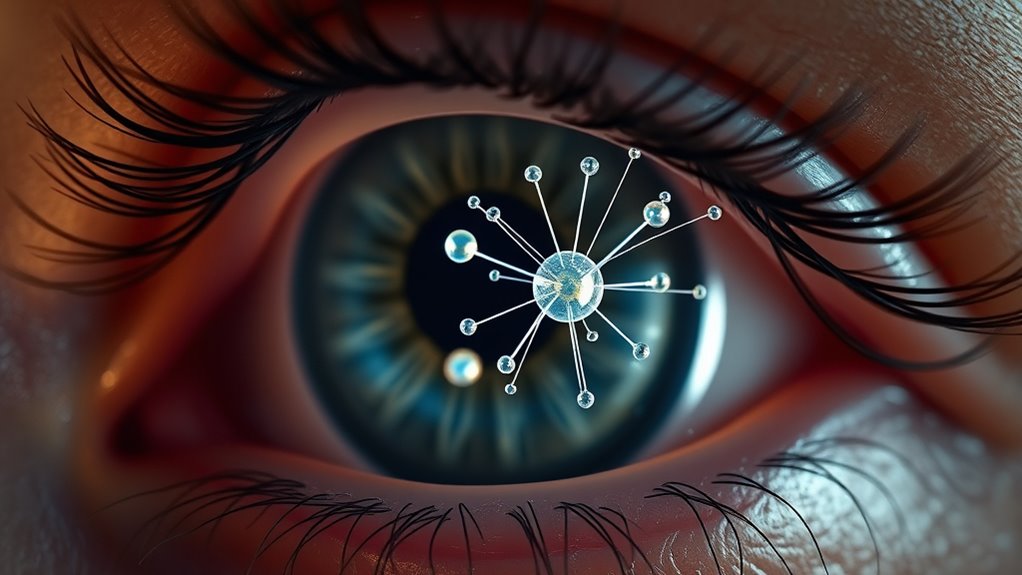
Nanomachines are revolutionizing drug delivery in ophthalmology by overcoming the barriers that typically hinder medication from reaching the retina effectively. The eye’s protective structures, like the cornea and blood-retinal barrier, limit drug penetration, making treatment challenging. Nanomachines are designed to navigate these obstacles by enhancing permeability and targeting specific tissues. Their small size allows them to pass through tight junctions, while surface modifications enable better adhesion and controlled release. Additionally, nanomachines can respond to environmental cues, releasing drugs precisely where needed. This targeted approach minimizes side effects and maximizes therapeutic efficiency. By improving penetration and precision, nanomachines help ensure that drugs reach the retina in effective concentrations, overcoming the eye’s natural defenses that traditionally restrict medication access. Use of metaphors in describing the complex navigation of nanomachines can help in illustrating their ability to bypass these barriers effectively.
Current Research and Breakthroughs in Ocular Nanomedicine
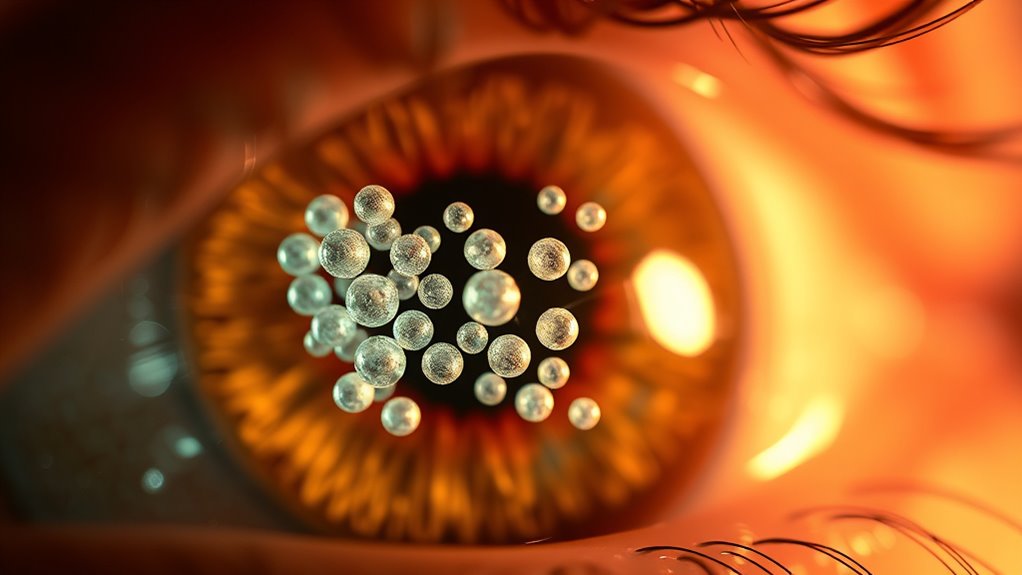
Recent advancements in ocular nanomedicine are opening new avenues for treating eye diseases more effectively. Researchers are developing smart nanomachines that target specific cells, reducing side effects and increasing treatment precision. Breakthroughs include nanocarriers designed to deliver drugs across the blood-retinal barrier, improving treatment for conditions like age-related macular degeneration. Innovative surface modifications allow nanodevices to evade immune detection and stay longer in ocular tissues. Additionally, stimuli-responsive nanomaterials release medication only when triggered by environmental cues, enhancing safety and efficiency. These breakthroughs are paving the way for minimally invasive therapies, faster recovery times, and improved patient outcomes. The ongoing research continues to push the boundaries of nanomedicine, promising a future where eye diseases are managed more effectively than ever before.
Challenges and Safety Considerations in Developing Nanomachines
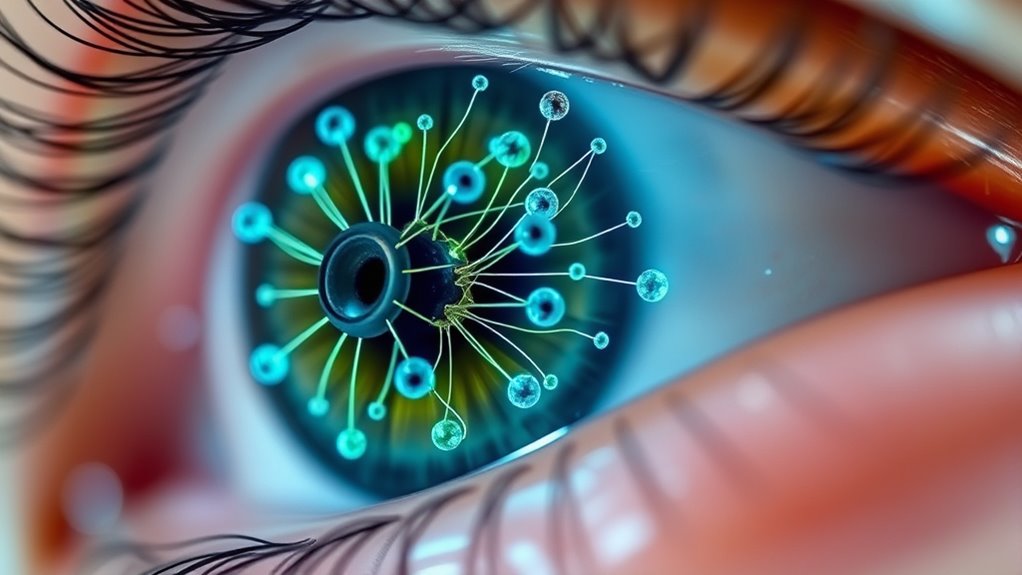
Developing nanomachines for ocular applications presents significant challenges, particularly in guaranteeing their safety and biocompatibility within sensitive eye tissues. You must carefully design these devices to avoid toxicity, inflammation, or immune reactions that could harm the eye. The small size of nanomachines makes controlling their interactions with cells and fluids complex, increasing the risk of unintended effects. You also need to confirm these nanomachines can be safely eliminated from the eye after they fulfill their purpose, preventing accumulation and long-term damage. Regulatory hurdles add another layer of difficulty, as you’ll need thorough testing and validation to meet safety standards. Balancing effective drug delivery with minimal risk is vital to developing nanomachines that are both safe and functional for eye treatments.
Future Perspectives and Potential Applications in Ophthalmology
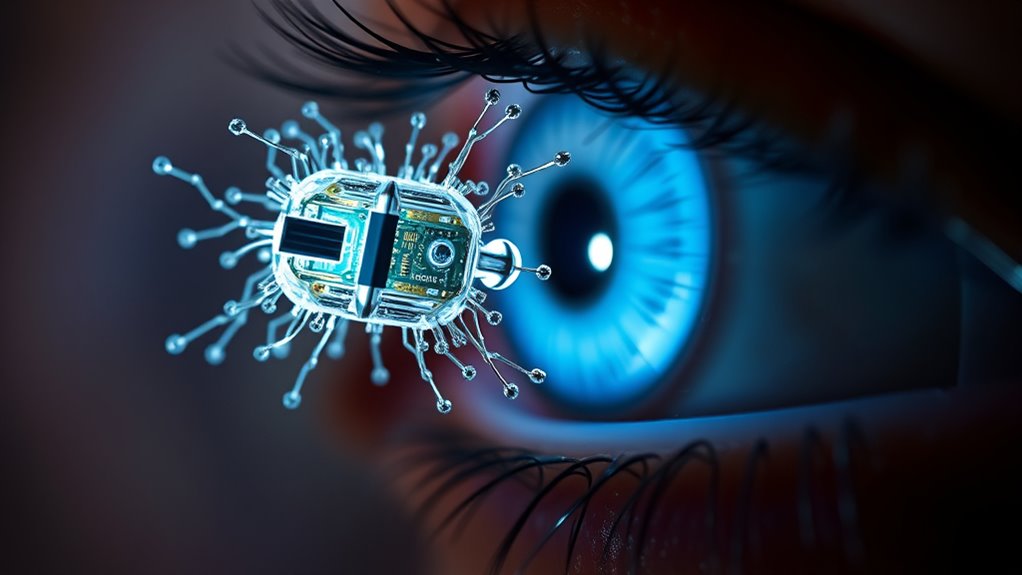
Future nanomachines could revolutionize ophthalmology by enabling highly targeted therapies with fewer side effects. They may also facilitate minimally invasive procedures, reducing recovery times and improving patient comfort. Additionally, personalized treatment strategies could become more effective as nanomachines adapt to individual patient needs.
Enhanced Targeted Therapy
How might nanomachines revolutionize targeted therapy in ophthalmology? They could enable precise delivery of drugs directly to affected eye tissues, minimizing side effects and maximizing effectiveness. By steering complex ocular barriers, nanomachines can reach deep-seated cells that traditional methods miss. This precise targeting could improve treatment outcomes for conditions like age-related macular degeneration or diabetic retinopathy. Additionally, nanomachines can be engineered to release drugs in response to specific stimuli, ensuring timely intervention. They also open avenues for personalized medicine, tailoring treatments to individual patient needs.
- Enhanced precision in drug delivery
- Reduced systemic side effects
- Controlled, stimuli-responsive release
- Potential for real-time monitoring and adjustments
Minimally Invasive Procedures
Nanomachines in ophthalmology are paving the way for minimally invasive procedures that can transform patient care. These tiny devices enable precise interventions with less tissue damage, faster recovery, and reduced risks. Imagine a table illustrating different applications:
| Application | Benefit |
|---|---|
| Intraocular injections | Reduced discomfort and precision |
| Targeted laser therapy | Minimal tissue disruption |
| Tear film repair | Non-invasive, quick healing |
| Drug-loaded nanodevices | Controlled release, fewer side effects |
| Ocular surface diagnostics | Real-time, non-invasive assessment |
These advances allow you to receive treatments that are less painful, more accurate, and faster. As technology progresses, minimally invasive procedures will become standard, enhancing outcomes and patient comfort in ophthalmic care.
Personalized Treatment Strategies
Advances in nanotechnology are opening new possibilities for personalized ophthalmic treatments that cater specifically to each patient’s unique needs. With nanomachines, you can receive tailored drug delivery that targets specific eye conditions precisely where they’re needed, reducing side effects and improving outcomes. This customization could involve adjusting drug dosage, timing, or release mechanisms based on your genetic makeup or disease progression. Imagine treatments that adapt in real-time to changes in your eye health. Personalized strategies also enable early detection and intervention, preventing worsening of conditions. As research progresses, you’ll benefit from therapies that are more effective and less invasive.
- Tailored drug delivery systems
- Real-time health monitoring
- Adaptive treatment regimens
- Reduced side effects
Impact of Nanomachines on Patient Outcomes and Quality of Life
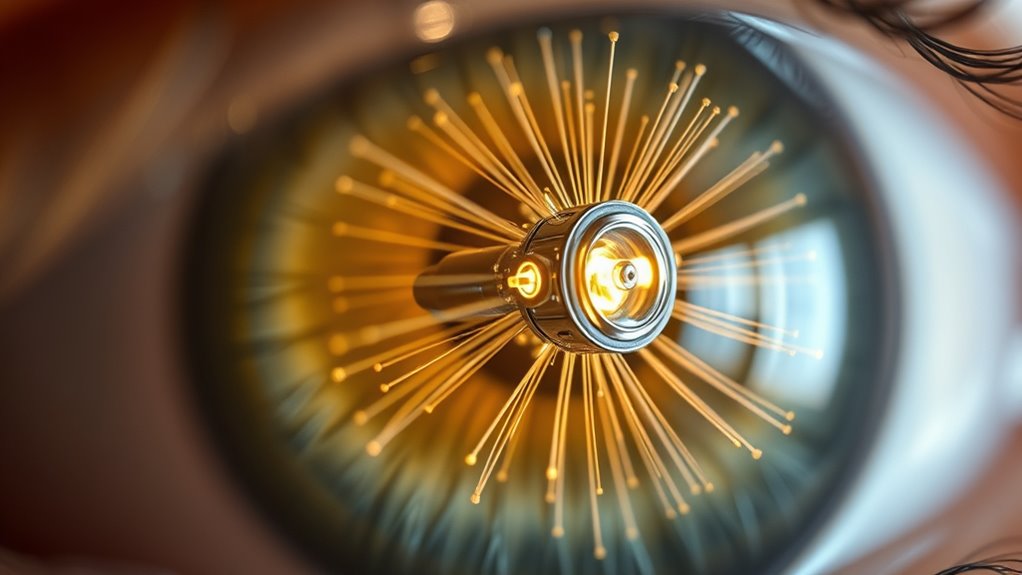
The integration of nanomachines into ophthalmology has the potential to substantially enhance patient outcomes and improve quality of life. By delivering drugs precisely where needed, nanomachines reduce side effects and increase treatment effectiveness. This targeted approach means you’ll experience faster relief and better management of eye conditions like glaucoma or AMD. With less invasive procedures, recovery times shorten, and discomfort decreases. You may also benefit from fewer hospital visits and more consistent treatment results. As nanomachines enable personalized therapies, your treatment becomes more tailored to your specific needs, leading to higher satisfaction. Overall, these innovations can restore vision more effectively and reduce the burden of eye diseases, helping you enjoy a better quality of life with clearer vision and improved daily functioning.
Frequently Asked Questions
How Long Do Nanomachines Stay Effective Inside the Eye?
Nanomachines typically stay effective inside your eye for a few days to several weeks, depending on their design and the purpose of the treatment. If they’re engineered for sustained release, they can last longer, gradually delivering medication. You might need periodic reapplications or replacements to maintain effectiveness. Your healthcare provider will determine the best schedule for your specific condition, ensuring ideal treatment without unnecessary interventions.
Are Nanomachines Reusable or Single-Use?
Nanomachines are designed to be like tiny superheroes, often reusable after completing their mission. You can think of them as smart tools that can be reactivated or guided for multiple treatments, reducing waste and increasing efficiency. However, their reusability depends on the specific design and purpose. With advancements, many are built to withstand multiple uses, making them more sustainable and cost-effective for ongoing eye treatments.
What Are the Costs Associated With Nanomachine-Based Treatments?
The costs of nanomachine-based treatments can be high, often due to research, development, and manufacturing expenses. You might face significant prices initially, but as technology advances and becomes more widespread, costs could decrease. Insurance coverage may vary, so it is crucial to check your plan. While the upfront costs are substantial, these treatments could offer more effective, targeted therapy, potentially reducing long-term healthcare expenses and improving eye health outcomes.
Can Nanomachines Cause Immune Reactions or Allergies?
Yes, nanomachines can cause immune reactions or allergies. Your body might recognize them as foreign, triggering immune responses. Researchers are working to design nanomachines with biocompatible materials to minimize this risk. Still, individual reactions vary, so you should discuss any concerns with your healthcare provider. They can evaluate your medical history and monitor for potential allergic or immune reactions during treatment.
How Do Nanomachines Compare to Traditional Eye Drop Treatments?
Imagine traditional eye drops as a flood leaving some medication behind, while nanomachines are like precision-guided missiles delivering drugs exactly where needed. Compared to eye drops, nanomachines offer targeted, controlled drug release, reducing side effects and improving effectiveness. They can cross barriers more efficiently, ensuring better treatment. So, you get faster relief and fewer doses, making your eye care more efficient and less invasive.
Conclusion
As nanomachines revolutionize eye care, the future holds incredible possibilities you can’t afford to ignore. Imagine targeted treatments that precisely address your eye condition, reducing side effects and improving outcomes. But as this technology advances, questions about safety and long-term effects remain. Will these tiny marvels change your life forever? Stay tuned—what’s coming next might just redefine how you see the world, and your future.
